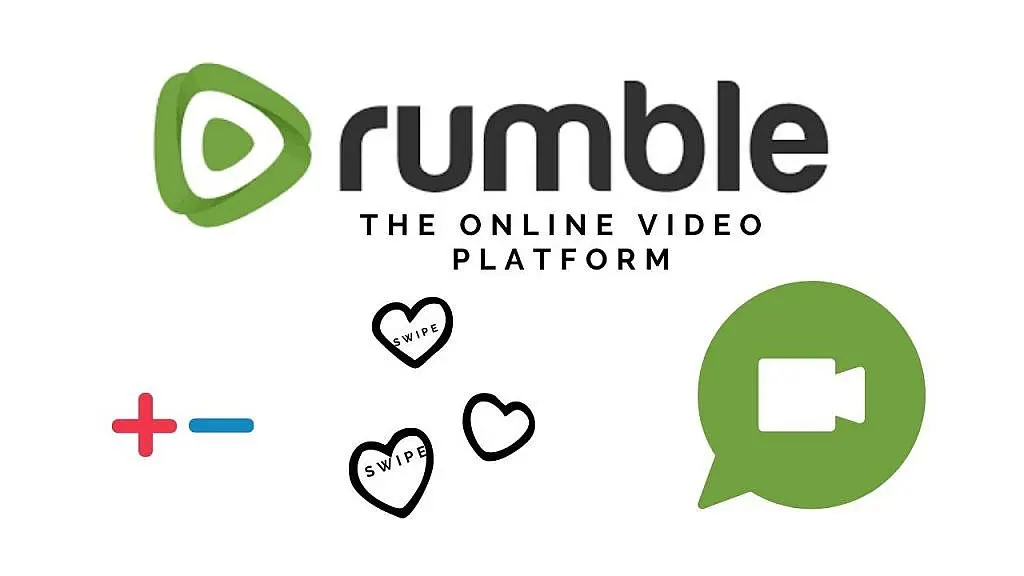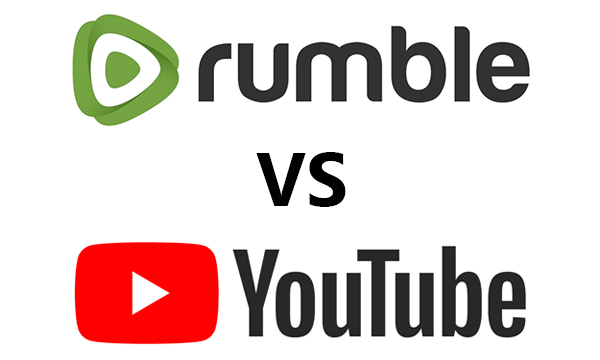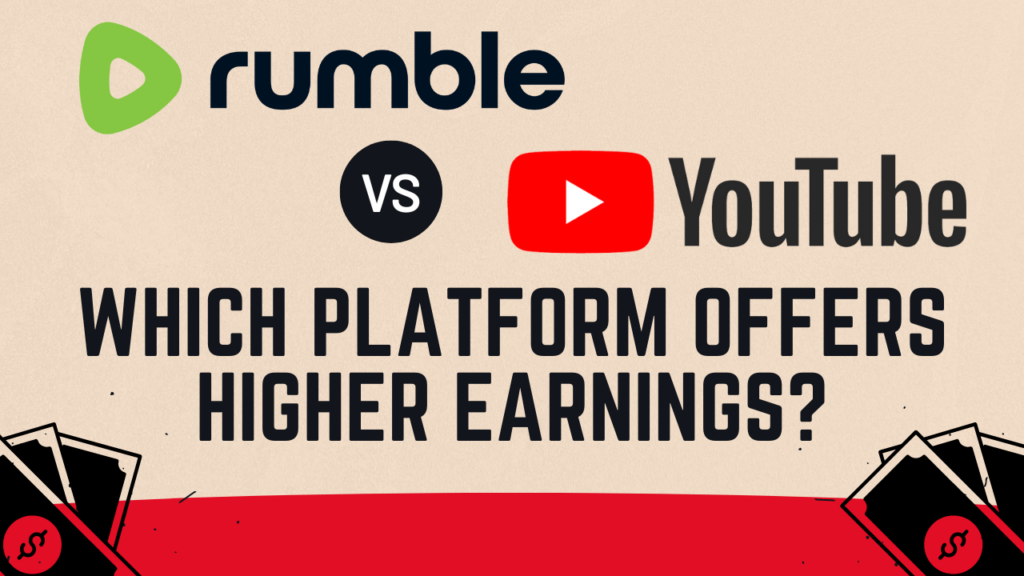Introduction
Video-sharing platforms have revolutionized the way we consume and create content, offering individuals the opportunity to showcase their talents and monetize their work. Among the many platforms available, Rumble and YouTube have emerged as prominent contenders, each with its unique features and monetization models. For content creators, choosing the right platform can greatly impact their earning potential and overall success. In this blog post, we will delve into a comparative analysis of Rumble and YouTube, focusing on which platform offers higher earnings.
We will explore Rumble's emphasis on creator monetization, its revenue-sharing model, and success stories from content creators. Similarly, we will examine YouTube's dominant position in the industry, its monetization program, and the challenges faced by creators. By weighing the pros and cons of each platform, we aim to provide valuable insights that will help creators make an informed decision regarding their choice of platform and maximize their earning potential in the competitive world of video content creation.
Also Read This: Sign Out of YouTube TV on Your Phone and Secure Your Account
Understanding Rumble

A. Overview of Rumble:
Rumble is a video-sharing platform that has gained popularity for its focus on creator monetization. It provides content creators with an opportunity to earn revenue from their videos while maintaining control over their content. Unlike traditional video-sharing platforms, Rumble aims to offer fair compensation to creators for their work.
B. Revenue Sharing Model:
Rumble's revenue-sharing model is designed to benefit creators. It offers a competitive revenue split, ensuring that creators receive a significant portion of the ad revenue generated by their videos. This model incentivizes creators to produce high-quality content and engage with their audience to maximize their earnings.
C. Case Studies and Testimonials:
Numerous success stories and testimonials highlight the earning potential of Rumble. Many creators have reported higher earnings on Rumble compared to other platforms. These success stories demonstrate the platform's ability to provide a lucrative monetization opportunity for content creators.
D. Licensing Opportunities and Content Syndication:
One unique aspect of Rumble is its emphasis on licensing and content syndication. Rumble partners with various media outlets and content creators have the opportunity to license their videos for use in television, online publications, and other platforms. This opens up additional revenue streams for creators beyond traditional ad revenue.
E. Creator Support and Resources:
Rumble provides support and resources for creators to enhance their success. The platform offers assistance in optimizing videos for maximum visibility and engagement. Additionally, creators can access a community of like-minded individuals and experts who can provide guidance and collaboration opportunities.
F. Advantages over Traditional Platforms:
Compared to traditional video-sharing platforms, Rumble offers several advantages for creators. It provides a fairer revenue split, opportunities for licensing and content syndication, and a supportive community. These factors contribute to Rumble's appeal as a platform that prioritizes the financial success and growth of its creators.
"The tweet below is about Rumble monetization."
Rumble promoted and profited from an unhinged, harrowingly antisemitic and homophobic six-hour livestream
The monetized Rumble video shows the platform flagrantly violates Google Play and Apple’s
App Store policies against hate speech*dated ydayhttps://t.co/Yz6R1tIUZU
— Oracle (@OracleNYSE) June 8, 2023
Also Read This: Master Football Techniques Like Ronaldo Using Dailymotion Videos
Examining YouTube
A. Overview of YouTube:
YouTube is the leading video-sharing platform with a massive user base and a vast content library. It has become a go-to platform for creators to share their videos, gain exposure, and potentially monetize their content. With its widespread reach and established community, YouTube offers creators significant visibility and discoverability.
B. Ad Revenue and Monetization:
YouTube's primary monetization program is the YouTube Partner Program (YPP). To qualify for monetization, creators need to meet certain requirements, such as having at least 1,000 subscribers and 4,000 watch hours within the past 12 months. Once eligible, creators can monetize their videos through ads, earning a share of the revenue generated.
C. Additional Monetization Features:
In addition to ad revenue, YouTube offers various features that allow creators to further monetize their channels. These include Super Chat, where viewers can pay to have their messages highlighted during live streams, Channel Memberships that offer exclusive perks to subscribers, and the Merchandise Shelf, enabling creators to sell their branded merchandise directly on their channel.
D. Challenges and Limitations:
Despite its popularity, YouTube does present challenges and limitations for creators. The platform's algorithmic changes can impact a creator's visibility and reach, potentially affecting their ad revenue. Moreover, YouTube's content policies and community guidelines are becoming stricter, leading to demonetization or limited monetization for some creators.
E. Revenue Fluctuations and Uncertainty:
YouTube's ad revenue can be subject to fluctuations, as it relies on factors such as ad rates, viewer engagement, and advertiser demand. Creators may experience inconsistent earnings due to these fluctuations, making it challenging to rely solely on YouTube as a consistent revenue stream.
F. Creator Support and Resources:
YouTube provides a range of resources, tutorials, and analytics tools to help creators optimize their content and grow their channels. The platform also offers support through creator forums, workshops, and partnerships with selected creators to foster community engagement and learning opportunities.
G. YouTube Premium:
YouTube Premium is a subscription-based service that allows users to watch ad-free videos, access exclusive content, and support creators through a revenue share based on watch time from Premium subscribers. This additional revenue stream can contribute to a creator's earnings on the platform.
H. Competitive Landscape:
YouTube faces increasing competition from other video-sharing platforms, which may impact creators' earning potential. As new platforms emerge, creators need to consider their niche, target audience, and the platform's monetization options to make an informed decision about where to focus their content creation efforts.
In conclusion, YouTube's massive user base and monetization options provide creators with significant earning potential. However, creators must navigate challenges such as algorithmic changes, content policies, revenue fluctuations, and increasing competition. Understanding the dynamics of YouTube's monetization program and taking advantage of additional features is crucial for creators to optimize their earnings on the platform.
"The video below examines YouTube and its features."
Also Read This: How to Download Audio from a YouTube Video
Rumble Vs YouTube: A Comparative Analysis

A. Earning Potential:
When comparing the earning potential of Rumble and YouTube, several factors come into play. Both platforms offer revenue-sharing models, but the specifics differ.
- Revenue Sharing Models: Rumble provides creators with a competitive revenue split, ensuring they receive a significant portion of the ad revenue generated by their videos. The platform's emphasis on fair compensation can result in higher earnings for creators.
YouTube's revenue-sharing model involves ads placed on videos, where creators earn a percentage of the revenue. However, YouTube's algorithmic changes and fluctuating ad rates can impact earning potential, making it more unpredictable compared to Rumble.
- Additional Monetization Features: While both platforms offer additional monetization features, YouTube has a wider range of options. Creators can earn through Super Chat, Channel Memberships, and the Merchandise Shelf. These features can provide supplementary income beyond ad revenue.
Rumble, on the other hand, offers unique monetization opportunities through licensing and content syndication. Creators can earn revenue by licensing their videos for use in other media outlets and platforms. This diversification of revenue streams can be advantageous for creators.
B. Monetization Options and Flexibility:
Rumble and YouTube have different approaches to monetization, offering creators varying levels of flexibility.
- Rumble's Focus on Creator Monetization: Rumble's primary focus is on providing fair compensation and monetization opportunities for creators. The platform's revenue-sharing model and licensing options allow creators to have more control over their earnings and leverage their content in different ways.
- YouTube's Established Monetization Program: YouTube's monetization program, the YouTube Partner Program (YPP), offers creators the ability to monetize their content through ads. However, the program has eligibility requirements and policies that creators must adhere to. The platform's additional monetization features provide flexibility but may be subject to fluctuating earnings.
C. Creator Support and Community:
The support and community engagement on Rumble and YouTube can significantly impact a creator's success and growth.
- Rumble's Creator Support: Rumble provides resources, optimization tools, and a supportive community to help creators succeed. The platform offers guidance on video optimization, licensing opportunities, and a network of fellow creators to collaborate and share insights.
- YouTube's Extensive Creator Resources: YouTube offers a wealth of resources, tutorials, analytics tools, and community forums to assist creators. The platform's vast user base also provides opportunities for collaboration and audience engagement.
D. Audience Reach and Discoverability:
YouTube's massive user base and established position in the video-sharing space contribute to its broad audience reach and discoverability.
- YouTube's Dominance in Video-Sharing: With billions of monthly active users, YouTube offers creators the potential for widespread visibility and exposure. Its robust search and recommendation algorithms can help content reach a larger audience.
- Rumble's Growing Popularity: While Rumble's user base may be smaller compared to YouTube, its emphasis on fair compensation and unique monetization options is attracting creators seeking higher earnings. As Rumble continues to grow, it presents an opportunity for creators to reach a niche audience and potentially earn more per view.
Also Read This: Achieve Voluminous Hair with a Round Brush Blow Dry Technique
FAQs
Q1. How does Rumble's revenue-sharing model compare to YouTube's?
Rumble's revenue-sharing model offers a competitive revenue split, ensuring that creators receive a significant portion of the ad revenue generated by their videos. The platform focuses on providing fair compensation to creators, which can result in higher earnings compared to other platforms. On the other hand, YouTube's revenue-sharing model involves earning a percentage of the ad revenue generated by videos. However, YouTube's algorithmic changes, fluctuating ad rates, and stricter content policies can impact earning potential and make it more unpredictable compared to Rumble.
Q2. What are the additional monetization features available on YouTube and Rumble?
YouTube offers various additional monetization features such as Super Chat, where viewers can pay to have their messages highlighted during live streams, Channel Memberships that offer exclusive perks to subscribers, and the Merchandise Shelf for selling branded merchandise directly on the channel. Rumble, on the other hand, provides unique monetization opportunities through licensing and content syndication. Creators can license their videos for use in other media outlets and platforms, opening up additional revenue streams beyond ad revenue.
Q3. How does Rumble's creator support compare to YouTube's?
Rumble provides resources, optimization tools, and a supportive community to help creators succeed. The platform offers guidance on video optimization, licensing opportunities, and a network of fellow creators for collaboration and sharing insights. Similarly, YouTube offers a range of resources, tutorials, analytics tools, and community forums to assist creators. The platform's vast user base provides opportunities for collaboration and audience engagement. Both platforms prioritize supporting creators, but the specific support and resources may vary.
Q4. Which platform has a larger audience reach and better discoverability?
YouTube has a massive user base and is the leading video-sharing platform, offering creators the potential for widespread visibility and exposure. Its robust search and recommendation algorithms can help content reach a larger audience. Rumble's user base may be smaller compared to YouTube, but it is growing in popularity, particularly among creators seeking fair compensation. While YouTube provides a broader audience reach, Rumble's emphasis on fair compensation and unique monetization options can attract a niche audience and potentially result in higher earnings per view.
Q5. Should creators consider using both Rumble and YouTube?
Diversifying income streams and leveraging multiple platforms can be advantageous for creators. By using both Rumble and YouTube, creators can maximize their earning potential, reach different audiences, and take advantage of the unique features and monetization options offered by each platform. It is important to consider the content strategy, goals, and audience when deciding whether to use both platforms or focus on one.
Conclusion
In conclusion, the choice between Rumble and YouTube for content creators seeking higher earnings depends on various factors. Rumble's revenue-sharing model, focus on fair compensation, and unique licensing opportunities make it an attractive option for creators. On the other hand, YouTube's extensive monetization features, larger user base, and established position in the industry provide broader reach and potential for exposure.
Creators should consider their goals, content niche, and long-term earning strategies when deciding which platform aligns best with their needs. Additionally, diversifying income streams and utilizing both platforms can be a viable strategy to maximize earning potential in the competitive video-sharing landscape.
